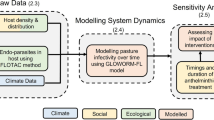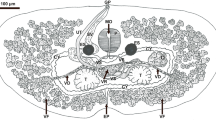Abstract
Fibropapillomatosis (FP) threatens the survival of green turtle (Chelonia mydas) populations at a global scale, and human activities are regularly pointed as causes of high FP prevalence. However, the association of ecological factors with the disease’s severity in complex coastal systems has not been well established and requires further studies. Based on a set of 405 individuals caught over ten years, this preliminary study provides the first insight of FP in Martinique Island, which is a critical development area for immature green turtles. Our main results are: (i) 12.8% of the individuals were affected by FP, (ii) FP has different prevalence and temporal evolution between very close sites, (iii) green turtles are more frequently affected on the upper body part such as eyes (41.4%), fore flippers (21.9%), and the neck (9.4%), and (iv) high densities of individuals are observed on restricted areas. We hypothesise that turtle’s aggregation enhances horizontal transmission of the disease. FP could represent a risk for immature green turtles’ survival in the French West Indies, a critical development area, which replenishes the entire Atlantic population. Continuing scientific monitoring is required to identify which factors are implicated in this panzootic disease and ensure the conservation of the green turtle at an international scale.





Similar content being viewed by others
References
Adnyana W, Ladds PW, Blair D (1997) Observations of fibropapillomatosis in green turtles (Chelonia mydas) in Indonesia. Australian Veterinary Journal 75:737–742. https://doi.org/10.1111/j.1751-0813.1997.tb12258.x
Akaike H (1973) Information theory and an extension of the maximum likelihood principle. In: Proceedings of the Second International Symposium on Information Theory, Petrov BN, Caski F (editors) Akademiai Kiado, Budapest, pp 267–281; https://doi.org/10.1007/978-1-4612-1694-0_15.
Aminot A, Chaussepied M (1983) Manuel des Analyses Chimiques en Milieu Marin. CNEXO Editions Jouve: Paris, 395 PP.
Bates D, Maechler M, Bolker B, Walker S, Christensen RHB, Singmann H, Dai B, Scheipl F, Grothendieck G, Green P, Fox J, Bauer A, Krivitsky PN (2012) Package ‘lme4’. CRAN. R Foundation for Statistical Computing. Retrieved from: https://github.com/lme4/lme4/.
Behrenfeld MJ, Falkowski PG (1997) Photosynthetic rates derived from satellite-based chlorophyll concentration. Limnology and Oceanography 42:1–20. https://doi.org/10.4319/lo.1997.42.1.0001
Bjorndal KA (1999) Priorities for research in foraging habitats. In: Research and Management Techniques for the Conservation of Sea Turtles, Eckert KL, Bjorndal KA, Abreu-Grobois FA, Donnelly M (editots) IUCN/SSC Marine Turtle Specialist Group Publication 4: 12–14.
Bonola M, Girondot M, Robin J-P, Martin J, Siegwalt F, Jeantet L, Lelong P, Grand C, Chambault P, Etienne D, Gresser J, Hielard G, Arqué A, Régis S, Lecerf N, Frouin C, Lefebvre F, Sutter E, Vedie F, Barnerias C, Thieulle L, Bordes R, Guimera C, Aubert N, Bouaziz M, Pinson A, Flora F, Duru M, Benhalilou A, Murgale C, Maillet T, Andreani L, Campistron G, Sikora M, Rateau F, George F, Eggenspieler J, Woignier T, Allenou J-P, Louis-Jean L, Chanteur B, Béranger C, Crillon J, Brador A, Habold C, Le Maho Y, Chevallier D (2019) Fine scale geographic residence and annual primary production drive body condition of wild immature green turtles (Chelonia mydas) in Martinique Island (Lesser Antilles). Biology Open 8:1–10. https://doi.org/10.1242/bio.048058
Burnham KP, Anderson DR (2002) Model selection and multimodel inference, 2nd ed., New York: Springer-Verlag, 485 PP.
Chaloupka M, Work TM, Balazs GH, Murakawa SKK, Morris R (2008) Cause-specific temporal and spatial trends in green sea turtle strandings in the Hawaiian Archipelago (1982–2003). Marine Biology 154:887–898. https://doi.org/10.1007/S00227-008-0981-4
Chambault P, De Thoisy B, Huguin M, Martin J, Bonola M, Etienne D, Gresser J, Hiélard G, Mailles J, Védie F, Barnerias C, Sutter E, Guillemot B, Dumont-Dayot E, Régis S, Lecerf N, Lefebvre F, Frouin C, Aubert N, Guimera C, Bordes R, Thieulle L, Duru M, Bouaziz M, Pinson A, Flora F, Queneherve P, Woignier T, Allenou J-P, Cimiterra N, Benhalilou A, Murgale C, Maillet T, Rangon L, Chanteux N, Chanteur B, Béranger C, Le Maho Y, Petit O, Chevallier D (2018) Connecting paths between juvenile and adult habitats in the Atlantic green turtle using genetics and satellite tracking. Ecology and Evolution 8:12790–12802. https://doi.org/10.1002/ece3.4708
Chaves A, Aguirre AA, Blanco-Peña K, Moreira-Soto A, Monge O, Torres AM, Soto-Rivas JL, Lu Y, Chacon D, Fonseca L, Jiménez M, Gutiérrez-Espeleta G, Lierz M (2017) Examining the Role of Transmission of Chelonid Alphaherpesvirus 5. EcoHealth 14:530–541. https://doi.org/10.1007/s10393-017-1248-7
da Silva CC, Klein RD, Barcarolli IF, Bianchini A (2016) Metal contamination as a possible etiology of fibropapillomatosis in juvenile female green sea turtles Chelonia mydas from the southern Atlantic Ocean. Aquatic Toxicology 170:42–51. https://doi.org/10.1016/j.aquatox.2015.11.007
Domiciano IG, Domit C, Bracarense LRFPA (2017) The green turtle Chelonia mydas as a marine and coastal environmental sentinel: anthropogenic activities and diseases. Semina Ciências Agrárias, Londrina 38:3417–3434. https://doi.org/10.5433/1679-0359.2017v38n5p3417
Foley AM, Schroeder BA, Redlow AE, Fick-Child KJ, Teas WG (2005) Fibropapillomatosis in stranded green turtles (Chelonia mydas) from the Eastern United States (1980–98): Trends and associations with environmental factors. Journal of Wildlife Diseases 41:29–41. https://doi.org/10.7589/0090-3558-41.1.29
Hargove S, Work T, Brunson S, Foley AM, Balazs G (2016) Proceedings of the 2015 International Summit on Fibropapillomatosis: Global Status, Trends, and Population Impacts. U.S. Dep. Commer., NOAA Tech. Memo., NOAA-TM-NMFS-PIFSC, 87 PP. DOI:https://doi.org/10.7289/V5/TM-PIFSC-54.
Herbst LH (1994) Fibropapillomatosis of marine turtles. Annual Review of Fish Diseases 4:389–425. https://doi.org/10.1016/0959-8030(94)90037-X
Herbst LH, Klein PA (1995) Green Turtle Fibropapillomatosis: Challenges to Assessing the Role of Environmental Cofactors. Environmental Health Perspectives 103:27–30. https://doi.org/10.1289/ehp.95103s427
Herbst LH, Ene A, Su M, Desalle R, Lenz J (2004) Tumor outbreaks in marine turtles are not due to recent herpesvirus mutations. Current Biology 14:697–699. https://doi.org/10.1016/j.cub.2004.08.040
Hily C, Duchêne J, Bouchon C, Bouchon-Navaro Y, Gigou A, Payri C, Védie F (2010) Les herbiers de phanérogames marines de l’outre-mer français, écosystèmes associés aux récifs coralliens. IFRECOR, Conservatoire du littoral, 140 PP.
Hothorn T, Zeileis A, Farebrother RW, Cummins C, Millo G, Mitchell D, Zeileis MA (2015) Package ‘lmtest’. CRAN. R Foundation for Statistical Computing. Retrieved from: https://github.com/cran/lmtest.
Impact Mer (2016) Suivi du milieu récepteur de l'émissaire de la STEU des Anses d'Arlet - Rapport pour : SICSM Martinique, 22 PP.
Jones K, Ariel E, Burgess G, Read M (2015) A review of fibropapillomatosis in Green Turtles (Chelonia mydas). The Veterinary Journal 212:48–57. https://doi.org/10.1016/j.tvjl.2015.10.041
Jones K, Burgess G, Budd AM, Huerlimann R, Mashkour N, Ariel E (2020) Molecular evidence for horizontal transmission of chelonid alphaherpesvirus 5 at green turtle (Chelonia mydas) foraging grounds in Queensland. Australia. PLoS ONE 5:e0227268. https://doi.org/10.1371/journal.pone.0227268
Lenth RV, Buerkner P, Herve M, Love J, Riebl H, Singmann H (2021) Estimated marginal means, aka least-squares means. CRAN. R foundation for Statistical Computing. Retrieved from: https://github.com/rvlenth/emmeans.
Murakawa SKK, Balazs GH, Ellis DM, Hau S, Eames SM (2000) Trends in fibropapillomatosis among green turtles stranded in the Hawaiian Islands, 1982–98. In: Proceedings of the 19th annual symposium on sea turtle biology and conservation. South Padre Island, Texas. NOAA Technical Memorandum NMFS-SEFSC-443, 239–241.
Nivière M, Chambault P, Pérez T, Etienne D, Bonola M, Martin J, Barnerias C, Védie F, Mailles J, Dumont-Dayot E, Gresser J, Hiélard G, Régis S, Lecerf N, Thieulle L, Duru M, Lefebvre F, Milet G, Guillemot B, Bildan B, Montgolfier B, Benhalilou A, Murgale C, Maillet T, Queneherve P, Woignier T, Safi M, Le Maho Y, Petit O, Chevallier D (2018) Identification of marine key areas across the Caribbean to ensure the conservation of the critically endangered hawksbill turtle. Biological Conservation 223:170–180. https://doi.org/10.1016/j.biocon.2018.05.002
Page-Karjian A, Norton TM, Ritchie B, Brown C, Mancia C, Jackwood M, Gottdenker NL (2015) Quantifying chelonid herpesvirus 5 in symptomatic and asymptomatic rehabilitating green sea turtles. Endangered Species Research 28:135–146. https://doi.org/10.3354/esr00687
Patrìcio AR, Diez CE, Van Dam RP, Godley BJ (2016) Novel insights into the dynamics of green turtle fibropapillomatosis. Marine Ecology Progress Series 547:247–255. https://doi.org/10.3354/meps11644
R Core Team (2020) R: A language and environment for statistical computing. R Foundation for Statistical Computing. Retrieved from http://www.R-project.org/.
Rittenburg LT, Kelley JR, Mansfield KL, Savage AE (2021) Marine leech parasitism of sea turtles varies across host species, seasons, and the tumor disease fibropapillomatosis. Diseases of Aquatic Organisms 143:1–12. https://doi.org/10.3354/dao03549
Rossi S, Sànchez-Sarmiento AM, Santos RG, Zamana RR, Prioste FES, Gattamorta MA, Ochoa PFC, Grisi-Filho JHH, Matushima ER (2019) Monitoring green sea turtles in Brazilian feeding areas: relating body condition index to fibropapillomatosis prevalence. Journal of the Marine Biological Association of the United Kingdom 99:1879–1887. https://doi.org/10.1017/S0025315419000730
Santos RG, Martins AS, Torezani E, Baptistotte C, Da Nobrega Farias J, Horta PA, Work TM, Balazs GH (2010) Relationship between fibropapillomatosis and environmental quality: a case study with Chelonia mydas off Brazil. Disease of Aquatic Organisms 89:87–95. https://doi.org/10.3354/dao02178
Seminoff JA (Southwest Fisheries Science Center, U.S.) (2004) Chelonia mydas. The IUCN Red List of Threatened Species 2004:e.T4615A11037468. Available:https://dx.doi.org/https://doi.org/10.2305/IUCN.UK.2004.RLTS.T4615A11037468.en. [Accessed October 23, 2021].
Shaver DJ, Walker JS, Backof TF (2019) Fibropapillomatosis prevalence and distribution in green turtles Chelonia mydas in Texas (USA). Diseases of Aquatic Organisms 136:175–182. https://doi.org/10.3354/dao03403
Siegwalt F, Benhamou S, Girondot M, Jeantet L, Martin J, Bonola M, Lelong P, Grand C, Chambault P, Benhalilou A, Murgale C, Maillet T, Andreani L, Campistron G, Jacaria F, Hielard G, Arqué A, Etienne D, Gresser J, Régis S, Lecerf N, Frouin C, Lefebvre F, Aubert N, Vedie F, Barnerias C, Thieulle L, Guimera C, Bouaziz M, Pinson A, Flora F, George F, Eggenspieler J, Woignier T, Allenou J-P, Louis-Jean L, Chanteur B, Béranger C, Crillon J, Brador A, Habold C, Le Maho Y, Robin J-P, Chevallier D (2020) High fidelity of immature green turtle (Chelonia mydas) to their foraging grounds revealed by satellite tracking and capture-mark-recapture and consequences for key marine conservation areas. Biological Conservation 250:108742; https://doi.org/10.1016/j.biocon.2020.108742.
Sposato P, Keating P, Lutz PL, Milton SL (2021) Evaluation of immune function in two populations of green sea turtles (Chelonia mydas) in a degraded versus a nondegraded habitat. Journal of Wildlife Diseases 57:761–772. https://doi.org/10.7589/JWD-D-20-00204
Torezani E, Baptistotte C, Mendes SL, Barata PCR (2010) Juvenile green turtles (Chelonia mydas) in the effluent discharge channel of a steel plant, Espirito Santo, Brazil, 2000–2006. Journal of the Marine Biological Association of United Kingdom 90:233–246. https://doi.org/10.1017/S0025315409990579
Van Houtan KS, Hargrove SK, Balazs GH (2010) Land use, macroalgae, and a tumor-forming disease in marine turtles. PLoS ONE 5:e12900; https://doi.org/10.1371/journal.pone.0012900.
Van Houtan KS, Smith CM, Dailer ML, Kawachi M (2014) Eutrophication and the dietary promotion of sea turtle tumors. PeerJ 2:e602; https://doi.org/10.7717/peerj.602.
Williams EH, Bunkley-Williams L (1994) An epizootic of cutaneous fibropapillomas in green turtles Chelonia mydas of the caribbean: Part of a panzootic? Journal of Aquatic Animal Health 6:70-78; https://doi.org/10.1577/1548-8667(1994)006<0070:AEOCFI>2.3.CO;2
Work TM, Dagenais J, Willimann A, Balazs G, Mansfield K, Ackermann M (2020) Differences in Antibody Responses against Chelonid Alphaherpesvirus 5 (ChHV5) Suggest Differences in Virus Biology in ChHV5-Seropositive Green Turtles from Hawaii and ChHV5-Seropositive Green Turtles from Florida. Journal of Virology 94:e01658-e1719. https://doi.org/10.1128/JVI.01658-19
Acknowledgements
This study was carried out within the framework of the Plan National d’Action Tortues Marines Antilles. The authors thank the DEAL Martinique, the ODE Martinique, the OFB Martinique, ONCFS Martinique, the ONEMA Martinique, the SMPE Martinique, the ONF Martinique, the PNR Martinique, the Surfrider Foundation, Plongée-Passion, the Collège Cassien Sainte-Claire, and the Collège Petit Manoir for their technical support and field assistance. We are also grateful to the numerous volunteers and free divers for their participation in the field operations and to the anonymous reviewers for their helpful corrections and comments.
Funding
The present study was co-financed by the FEDER Martinique and DEAL Martinique (European Union, Conventions 2012/DEAL/0010/4-4/31882, 2014/DEAL/0008/4-4/32947 & 2017/164894), ODE Martinique (Conventions 014-03-2015 and 180126). ERDF fund (Convention CNRS-EDF-juillet 2013) and Fondation de France (Subvention Fondation Ars Cuttoli Paul Appell). Support for the ANTIDOT project was appreciated (Pépinière Interdisciplinaire Guyane, Mission pour l'Interdisciplinarité, CNRS).
Author information
Authors and Affiliations
Corresponding author
Additional information
Thibaut Roost and Jo-Ann Schies are co-first authors.
Supplementary Information
Below is the link to the electronic supplementary material.
Rights and permissions
About this article
Cite this article
Roost, T., Schies, JA., Girondot, M. et al. Fibropapillomatosis Prevalence and Distribution in Immature Green Turtles (Chelonia mydas) in Martinique Island (Lesser Antilles). EcoHealth 19, 190–202 (2022). https://doi.org/10.1007/s10393-022-01601-y
Received:
Accepted:
Published:
Issue Date:
DOI: https://doi.org/10.1007/s10393-022-01601-y




